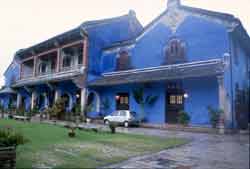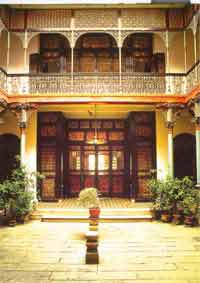West Coast
| Penang | Pulau Langkawi |

For my first trip to Asia the choice was to concentration my travels in a small area for an in-depth trip (for example spend 3 weeks in one country) or to do some hopping around and visit several areas. The Cathay Pacific All Asia Pass allows you to travel to up to 17 cities (in 9 countries) including Hong Kong in a three week period for one price. If you want to spend all your time on airplanes and in airports you could probably visit most of the cities but we decided on 3 cities (in three countries) plus Hong Kong. Since Cathay Pacific is based in Hong Kong you have to travel through Hong Kong for most legs of your pass. Plus its a long trip from North America, it was 19 hours from Toronto. With 17 cities in 9 countries our biggest decision was where to visit on our Cathay Pacific All Asia Pass, so much choice so little time. For Malaysia we wanted to visit the Borneo part of the country but there were no Cathy Pacific flights so Penang with its combination of history, beaches and modern living looked like a good option.
Penang
|
Penang is a confusing mixture of state and island. Most of the state of Penang is on the island of Penang which contains all the interesting things found in Penang state. The island is 285 square kilometres in size and connected to the town of Butterworth on the mainland by a 13 kilometre bridge, supposedly the longest in Southeast Asia, and a 24 hour ferry. The state capital, and Malaysia's second largest city, is sometimes also called Penang but its correct name is Georgetown, a city of about 1 million which is fighting a battle between the preservations and the industrials for the
architectural future of the city. A taxi from the airport will cost about RM25 and coupons are purchased from a desk inside the terminal, it takes about 30 minutes to get into the city.
Georgetown has the largest collection of pre-war buildings in Southeast Asia, get there before its all destroyed and Georgetown starts to look like Hong Kong. Georgetown is a multiethnic city containing Malays, Chinese and Indians living in a sometimes uneasy peace. Within a 10 minute walk you will see Christian churches, Indian mosques, Chinese temples, Hindu temples, Chinese clan houses, and modern skyscrapers. The city centre is small enough to walk around and catch the sights within a day, even when its pouring rain. The northeastern point of the island marks the spot where Captain Francis Light of the British navy first set foot on the island. It is also the location of Fort Cornwallis, a clock tower to commemorate the 50th anniversary of Queen Victoria, some colonial buildings, and the long-distance ferry terminal. The Penang Museum and Art Gallery is located next to the Anglican St. George's Church which is one of the oldest buildings in Penang. The museum has a good collection of rickshaws, press cuttings and photographs. Nearby is Little India and the Sri Mariamman Temple which is a typical example of Hindu architecture. |

The Khoo Kongsi is one of the many traditional Chinese clan houses in Penang. This is the wealthiest clan in Penang and they charge an admission of RM5 to visit the clan house and its museum. The original building was builted in 1894 but it was soon totally destroyed in a fire caused by a lightning strike. The clan took this to mean that the gods thought that the clan house was so beautiful it offended them so when they rebuilt a slightly less fanciful structure was builted. Slightly less!! This is an impressive building containing intricately carved beams and pillars and mother-of-pearl furniture. One room is a decorated shrine to the god of prosperity, Tua Peh Kong. Another room contains gilded ancestral tablets. The outside is covered in carvings of folk tales. To get to the clan house you have to walk down an alleyway that contains on excellent example of Penang row houses with second story veranda. Traditional the first floors were for business while the family lived upstairs.
|
At one point in the day, with the pouring rain, we had stopped under an overhang of another clan house to take a break. Streets were flooding and we were soaked. This turned out to be the Yeoh Kongsi and a young man invited us in and given a tour. The young man was a fountain of information. His parents lived through the Japanese occupation of the island. The British were not welcomed back after the war. "Where were you for 3 years 8 months." All lost time is now referred to as 3 years 8 months. The Chinese make up 51% of the population of the island but many have to go away for school because of quote systems that favour the Malays. In many clan houses there is a room
dedicated to those who have graduated from foreign universities, most seem to be in England or
Australia. Our guide certainly gave us a different perspective on Malaysia
ethnic policy from the public government policy.
Another building worth visiting is the Cheong Fatt Tze Mansion, a beautifully restored Chinese mansion, you can't miss it since the outer walls are a bright blue. With 38 rooms, 5 courtyards, 7 staircases and 220 windows its hard to believe that this building was totally dilapidated in 1990. It was the home of Cheong Fatt Tze who has been called "One of China's last Mandarin's and first capitalists. On his death in 1916 flags were flown at half mast in the British and Dutch colonies. This building is one of only two such Chinese mansions outside China. Although typical Chinese in floorplan the mansion contains Gothic louvered windows, Stoke-on-Trent floor tiles, Scottish cast iron works and Art Nouveau stained glass. Parts of the movie Indochine was filmed here. Outside the city centre is the largest Buddhist temple in Malaysia, Lok Si Temple. Its about a half hour by bus. After a long rainy day of sightseeing we decided maybe later. Until recently the tallest building in the world was in Malaysia, the Petronas Towers in Kuala Lumpur. It has recently been surpassed by a building in Taipei, Taiwan which will probably soon be surpassed by a building in Shanghai, China. The second tallest building in Malaysia is in Georgetown, called the KOMTAR building its 88 stories high and according to a taxi driver it was the site of a fire just before it opened, "Our own Towering Inferno". As an island in the tropics, Penang also has several sandy beaches. There are several large resort hotels but the water is polluted, the local coral has been damaged and the beaches are nothing special. For a more authentic experience head to Pulau Langkawi, which is a two hour ferry ride from Penang. |
|
Pulau Langkawi
|
About 30 km from the northern tip of the Malaysia peninsula is Pulau Langkawi the largest of 104 islands. There is a recently opened airport, some German tourists told us that Lufthansa might be starting direct flights from Germany. Ferries arrive from Penang, Kuala Perlis, Kuala Kedah and from Satun in Thailand. The ferry from Penang takes about two hours on a high speed ferry for RM35. It can be a bumpy ride, about half the people on the ferry got sea sick. You can also watch a pirated movie, the bad transfer was amusing with heads blocking the view, a shaking camera and background conversation. |

|

Kuah is the largest town on the island with about 12,000 people. If you come via ferry this is where it docks. Although a pleasant enough town some of the tourist infrastructure is kind of tacky like the statue of the giant eagle located in Dataran Lang (Eagle Square). Although there are plenty of hotels people generally don't come to places like this to stay in town, there are plenty of beaches. The tourism infrastructure is getting developed with several big hotels and resorts, several golf courses, "cultural attractions", a cable car with good views of the island and the other trapping of tourisms. The Germans liked visiting the KFC in Kuah, according to them there are none in Germany! My favourite fast food. The island seems to be popular with Germans and Saudis. I think we were the only native English speakers at the resort. There are no buses so unless you want to rent a vehicle, taxi is the only way to get around. Get there before it gets totally ruined, at 478 square kilometres its about the size of Singapore but only about 65,000 people live there so much of the island is still rural with mountains, jungles, some wildlife, diving, limestone outcrops, rice paddies and fishing villages. And of course white sandy beaches. |

The island was also used as the location for the Summer Palace scenes in the awful remake of Anna and the King. Not that the original was that great but then I generally hate musicals. You can visit the set - the book and movie is considered
offensive to the royal family in Thailand which is why the movie was shot in Malaysia. Near the movie set is also the location of the cable car and probably the islands best natural feature, Telaga Tujuh or Seven Wells with a 90 metre waterfall. Its a steep climb and watch for the
monkeys. Near Pantai Kok is a small island which at low tide you can easily walk to, there are several jungle trials and if your lucky, like I was, you can see otters.

I'm not much for beach resorts but Langkawi is pretty laid back with few backpackers and there are several other things on the island besides beaches. Two days was enough for me, a week or two at a place like this would bore me to tears but to each their own.
| Return to Travel Page |
Return to Main Page |

